This resource explains key terms related to T-Mobile’s network and emergency vehicles and assets used to help ensure seamless connectivity and support for customers, first responders and communities when it matters most.
Use the Table of Contents to navigate to sections to read more about each asset or concept grouped by type.
Key Restoration & Connectivity Assets
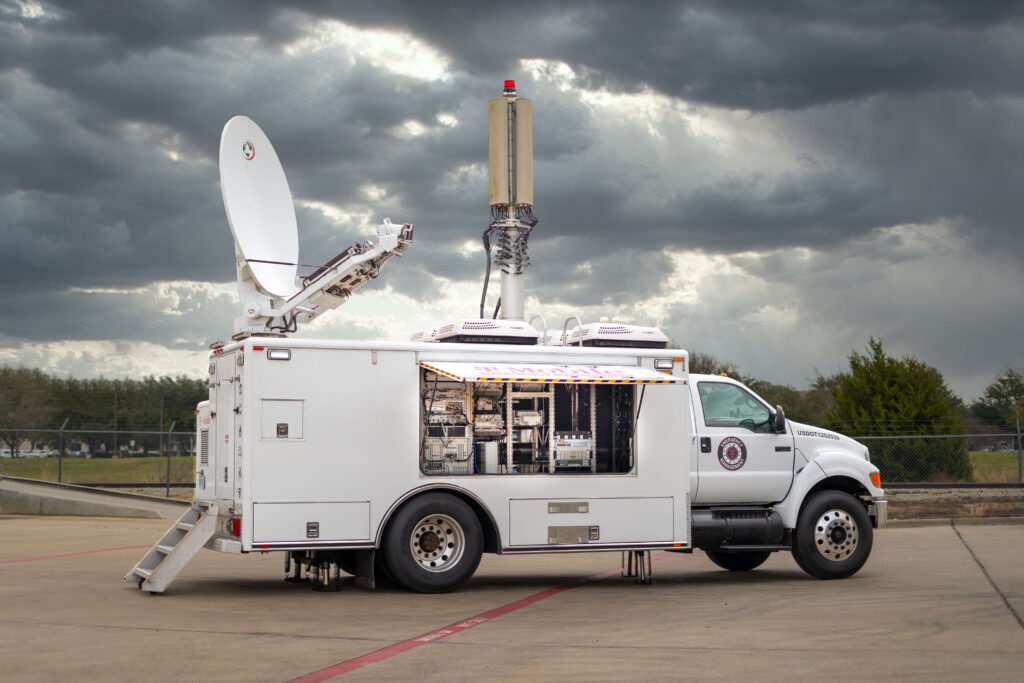
SatCOLT: A larger vehicle with high ground coverage and heavy-duty rolling gear that can provide call, text and data services to more people over a wider area, with a 65-foot mast that extends coverage up to five miles through microwave and high-throughput geosynchronous satellite backhaul, along with multi-band and high-capacity LTE and 5G. 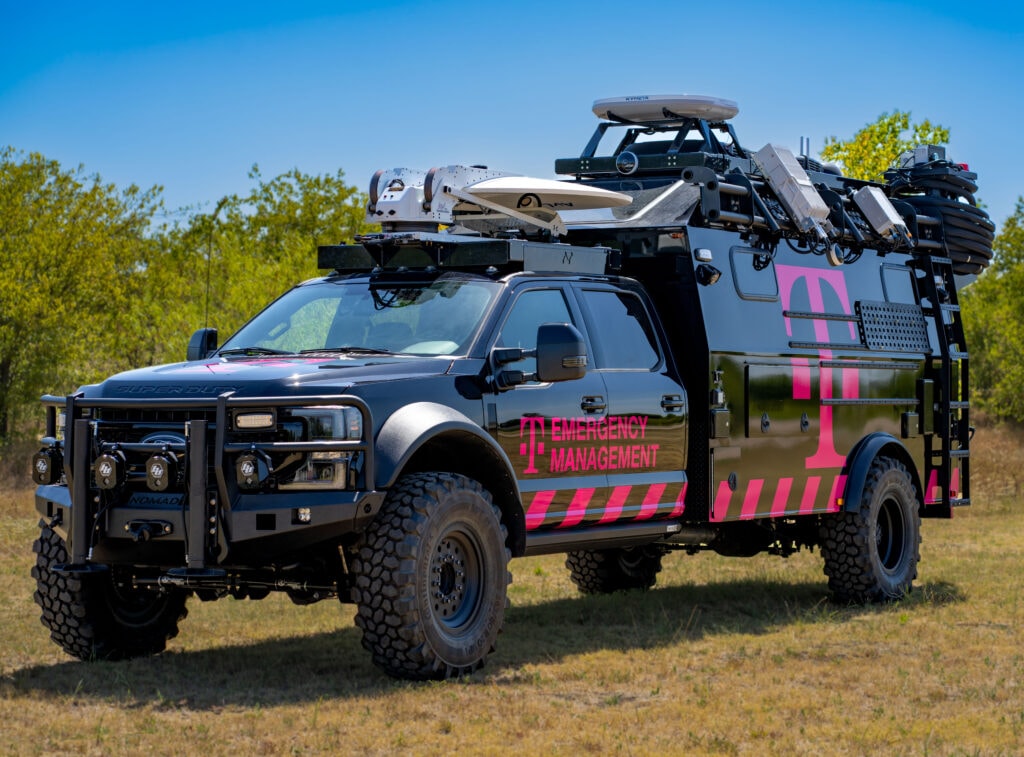
SatCOLT: A larger vehicle with high ground coverage and heavy-duty rolling gear that can provide call, text and data services to more people over a wider area, with a 65-foot mast that extends coverage up to five miles through microwave and high-throughput geosynchronous satellite backhaul, along with multi-band and high-capacity LTE and 5G. 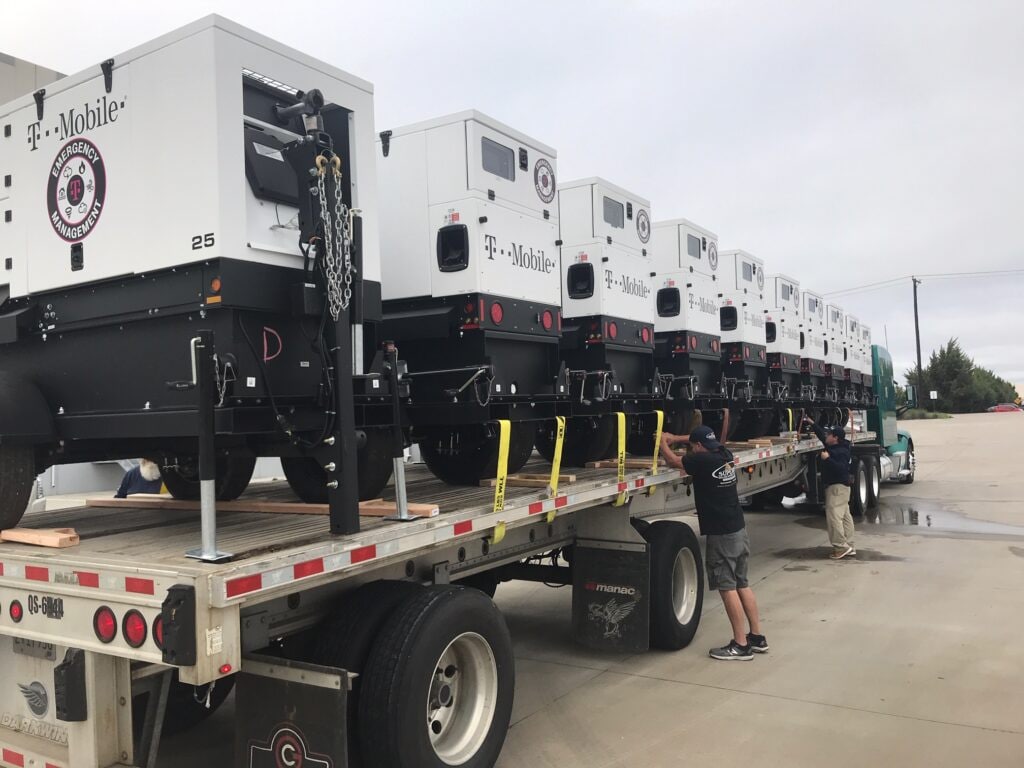
Mobile Generator: A towable device that provides electricity to keep cell sites and other critical infrastructure operating during a commercial power outage. These generators can power a cell site for three days without refueling. 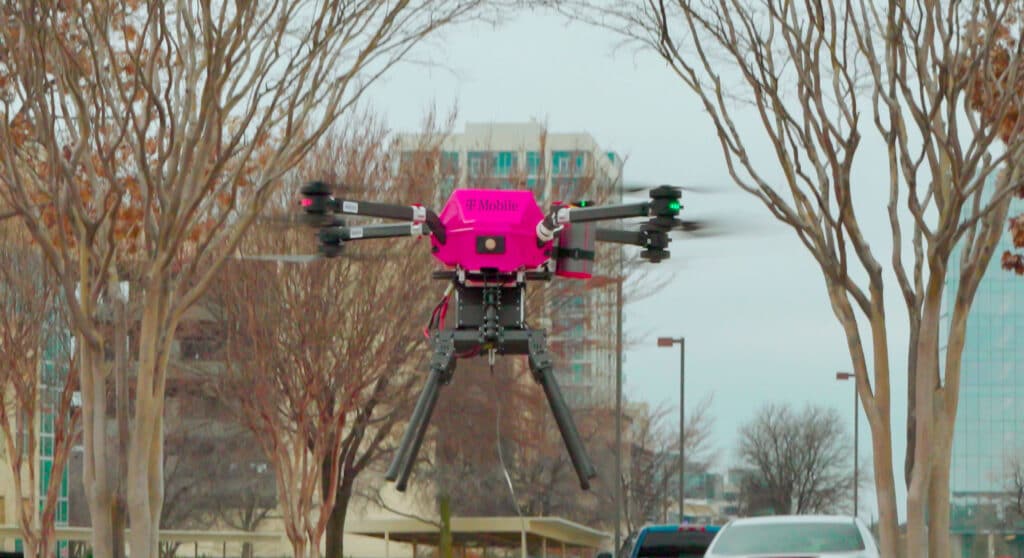
Tethered Drone: These drones are connected to power sources on the ground, allowing them to fly up to 300 feet high and provide wireless signal coverage over a two-mile range for extended periods of time. 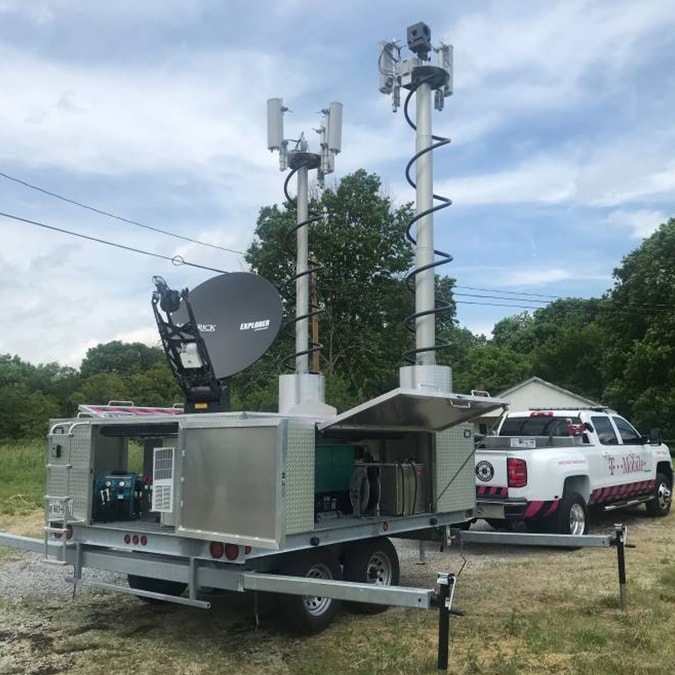
SatCOW: A towed trailer that provides wireless and Wi-Fi service within a one-mile radius, aiding communication and emergency response capabilities in critical areas like hospitals, evacuation shelters and government buildings. 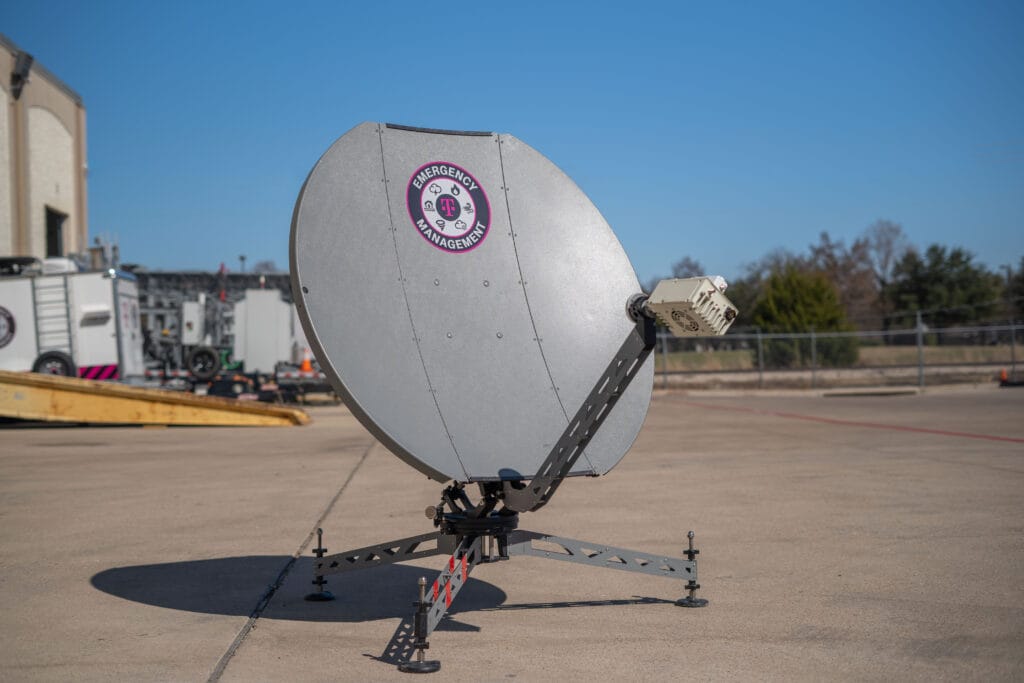
Very Small Aperture Terminal (VSAT): Small portable dishes, less than three meters wide, that connect to satellites (using satellite backhaul) and quickly provide temporary wireless service to send and receive data from T-Mobile’s network. 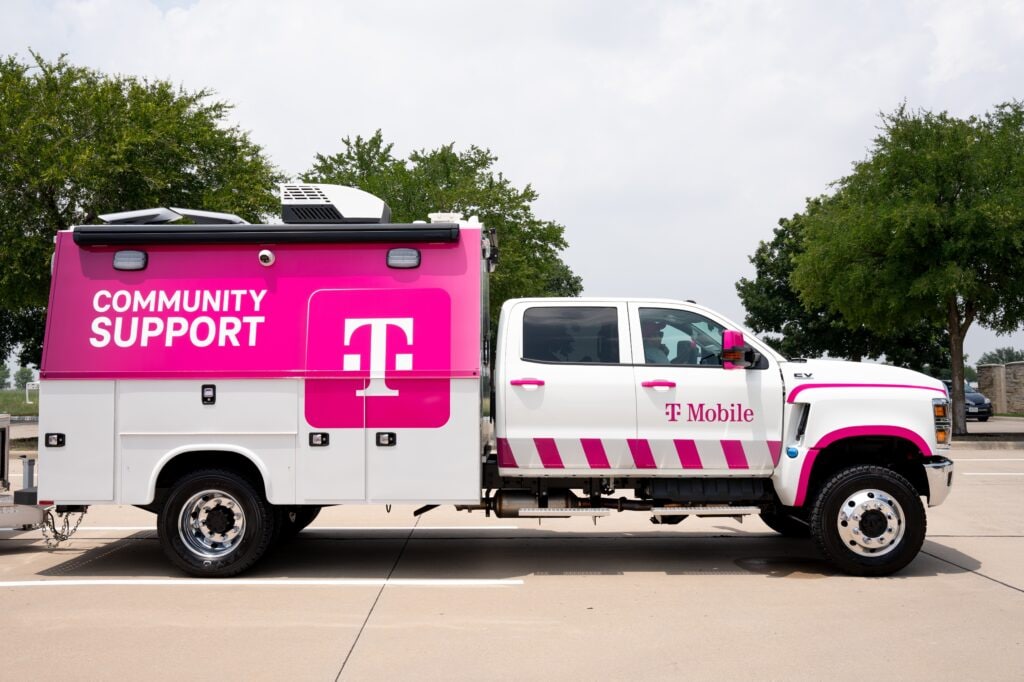
Community Support Truck: Heavy-duty trucks equipped with 80 charging ports and Wi-Fi that covers up to a half-mile radius. They carry essential supplies like portable chargers and cables to help keep people connected during emergencies. 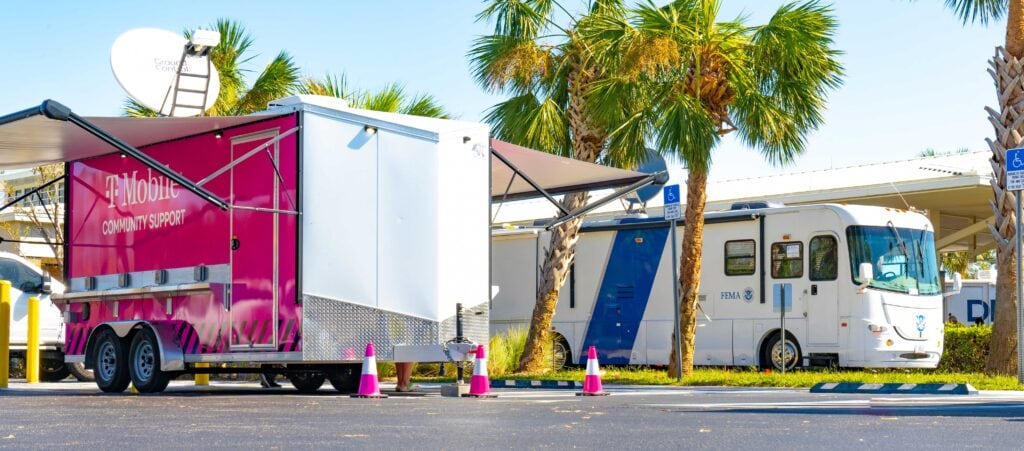
Wi-Fi Trailer: A trailer version of the Community Support Truck that can be stationary for long periods of time and provide continued support to communities. It offers Wi-Fi coverage up to half a mile from the trailer, 80 device charging outlets and storage for supplies. 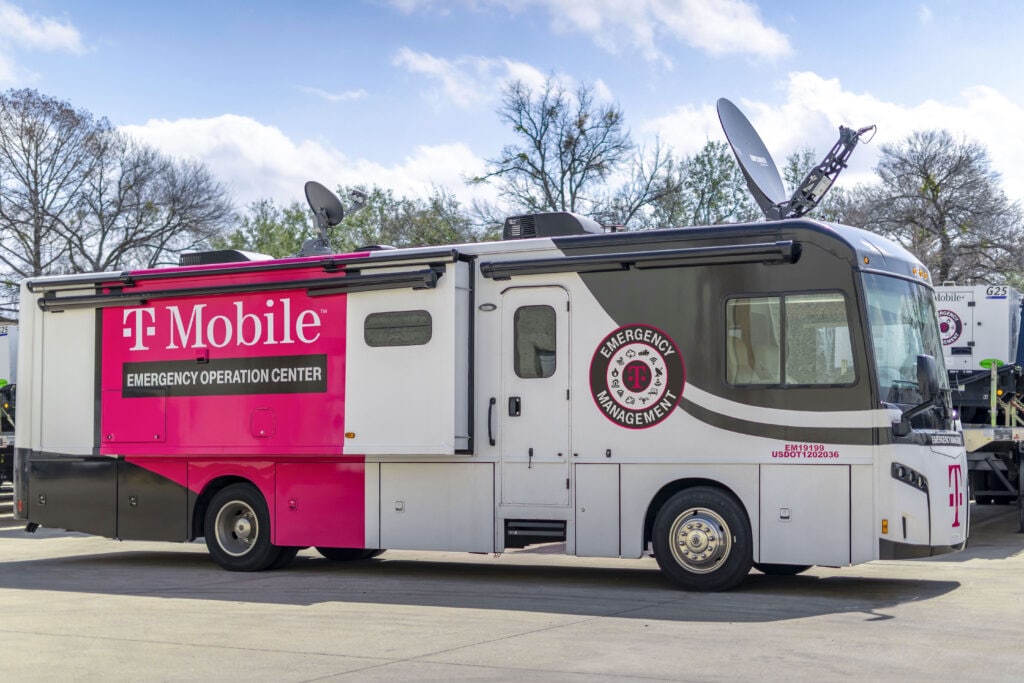
Emergency Operations Center: A large Class A RV that serves as a mobile operations platform for large deployments at major incidents. These vehicles offer network access and Wi-Fi for emergency teams, FEMA, public safety agencies and local officials. They have workstations, conferencing capabilities and an area for crew to rest.
Network Terminology
Backhaul: The high-speed connections between cell sites and a central hub — often a provider’s main network or switching facility — that near-instantly route data and voice traffic along the network. Think of backhaul as a digital version of a 1950s switchboard operator, but much faster and automatic. T-Mobile uses three main technologies to provide backhaul:
- Fiber Optic Cables: Physical cables, either strung above ground along utility poles or buried underground, that carry large amounts of data (high capacity) quickly (high speed) across the network. If these cables are damaged, other methods like microwave or satellite technology can temporarily provide backhaul until the cables are repaired.
- Microwave Connectivity: Portable antennas that send and receive data and voice traffic through short radio waves called “microwaves.” These waves allow for fast data speeds and large capacity over shorter distances. Antennas can be linked to each other, or “daisy chained,” to extend coverage across challenging terrain.
- Satellite Connectivity: Portable dishes that connect to satellites in space to send and receive wireless data and voice traffic communications using long radio waves. Satellite backhaul provides broad coverage when traditional ground-based infrastructure is damaged or not feasible.
Capacity: The amount of data, voice and text traffic that can be sent across the network.
Cell Sites: Structures containing antennas and other equipment that connect and support a wireless network, providing service and coverage to a geographic area. Cell sites vary in size, with coverage ranging from a few city blocks to 250 square miles. Types of cell sites include:
- Macro Cell Sites: Also known as “cell towers,” these antennas are placed on tall poles, metal structures or rooftops. They are typically 50 to 200 feet tall and deliver strong wireless coverage and high-capacity traffic across large areas.
- Small Cell Sites: Backpack-sized sites that are often attached to streetlights, lamp posts or buildings. They provide strong wireless coverage with high capacity over small areas, such as a few city blocks or busy tourist spots.
Coverage: The geographic area connected by wireless infrastructure.
Fixed Backup Generator: Permanent generators located at key cell sites and other critical buildings to keep them operational during a commercial power outage.
Network Hardening: The process of improving T-Mobile’s network infrastructure to make it more reliable and robust to reduce service interruptions. This includes adding layers of overlapping coverage, installing back up power sources such as fixed generators and batteries, and building additional backhaul routes at critical sites nationwide.
Network Resilience: Network resilience is the network’s ability to withstand disruptions like hurricanes, wildfires and other severe events while keeping customers connected. It’s the result of network hardening efforts.
Overlapping Coverage: A strategy of placing multiple cell sites close together so that if one goes offline, another nearby keeps customers connected.
Priority Access and Preemption: Priority Access and Preemption are features that ensure first responders, public safety agencies and other organizations that are part of the critical infrastructure of the United States have “lights and sirens” on their calls, texts, and data in times of an emergency. Priority Access moves their devices to the front of the line on the network, while Preemption clears other network activity if necessary to keep their communications flowing smoothly. It’s like controlling traffic lights to safely clear the way for an ambulance.
Wireless Priority Service (WPS): A federal program that gives priority to calls and data from registered public safety agencies on the network. All WPS subscribers automatically receive Priority Access and Preemption on the T-Mobile network, ensuring their communications are prioritized over others.
Advanced Technologies Enhancing Connectivity
Real-Time Threat Detection, Powered by AI: AI-driven alert systems constantly monitor global public data, from official agencies to breaking news, identify emerging threats like severe weather, infrastructure disruptions, or regional instability. Integrated directly into our Everbridge Visual Command Center, this Dataminr-powered feed gives our teams immediate visibility to assess risks and act quickly. The result is faster decision-making, improved coordination, and stronger resilience for the communities and operations we support.
Self-Organizing Network (SON): An AI and advanced automation platform that monitors and optimizes network performance in real time. It can reconfigure network settings, including tilting antennas and redirecting traffic. And if a site is running on a smaller generator or backup battery, SON helps extend that power— keeping people connected longer when it matters most.
T-Satellite with Starlink: The country’s first and only satellite-to-mobile solution that connects directly to your phone — no special app or hardware required. T-Satellite automatically connects when terrestrial towers are down, allowing people to send texts to family, friends or 911. It’s already helping keep people connected in rural areas and during major disasters, like hurricanes and wildfires.
T-Priority: T-Mobile’s cutting-edge emergency response solution — combining a dedicated 5G network slice with an ecosystem of tools, from drones and AI-powered applications to deployables and a dedicated emergency response team. The slice gives first responders up to 5 times the network resources of the average user and gives first responders more capacity, faster 5G speeds and the highest priority — every day but especially during massive emergencies.
Pano AI: T-Mobile has partnered with Pano AI to rapidly gather and process data, enabling the early detection and precise identification of wildfires. By utilizing AI-powered ultra-high-definition cameras, we can monitor an area during a wildfire and assist in containing fires at their initial stages, thereby protecting lives and property from potential devastation.
Emergency Vehicles & Deployable Assets
Mobile Generator: A towable device that provides electricity to keep cell sites and other critical infrastructure operating during a commercial power outage. These generators can power a cell site for three days without refueling.
Mobile Command Vehicles: T-Mobile uses various types of vehicles to manage and coordinate response efforts during disasters. These are deployed to specific locations in disaster zones, such as Incident Command Posts set up by public safety agencies, to create a centralized hub for on-site coordination and communication:
- Emergency Operations Center: A large Class A RV that serves as a mobile operations platform for large deployments at major incidents. These vehicles offer network access and Wi-Fi for emergency teams, FEMA, public safety agencies and local officials. They have workstations, conferencing capabilities and an area for crew to rest.
- Mobile Command Center: A large, triple-axel fifth wheel trailer that also operates as an operations platform with up to 15 workstations, sleeping accommodations for eight people and a restroom with a shower. This trailer is used for major incidents and training events with federal and state agencies.
- Community Support Command Center: A Class Super C RV outfitted with accommodations for up to six people including beds, a kitchen and a bathroom making it suitable for longer deployments or when local hotels aren’t available. It’s equipped with satellite and Wi-Fi and can serve as a secondary emergency operations center when needed.
SatCOLTS and SatCOWS
SatCOLT and SatCOW: Satellite Cell On Light Trucks (SatCOLTs) and Satellite Cell On Wheels (SatCOWs) are mobile cell sites used to provide connectivity in disaster areas. A SatCOLT is built into a vehicle and has its own power generator, while a SatCOW is a trailer-based cell site that can be towed. Both are used to restore and boost connectivity when needed.
T-Mobile has several different sizes of SatCOLTs and SatCOWs that can provide 5G, LTE and Wi-Fi:
- XL SatCOLT and XL SatCOW: These mobile cell towers on wheels, the largest in the fleet, are equipped with extendable masts that can rise up to 100 feet — about the height of a 10-story building. Built to deliver 5G and satellite-powered coverage across a 3 to 5 mile radius (roughly 74 football fields laid end to end), they’re T-Priority enabled and feature automated deployment and remote monitoring — designed to restore connectivity when communities need it most.
- Large SatCOLT: A larger vehicle with high ground coverage and heavy-duty rolling gear that can provide call, text and data services to more people over a wider area, with a 65-foot mast that extends coverage up to five miles through microwave and high-throughput geosynchronous satellite backhaul, along with multi-band and high-capacity LTE and 5G.
- Small SatCOLT: A small, agile vehicle that can travel through rugged and remote terrain to bring wireless and Wi-Fi coverage in hard-to-reach places.
- Dual Mast SatCOLT: A Satellite Cell Site on Light Truck equipped with two pneumatic masts (35 ft tall and 45 ft tall) with LEO/GEO satellite backhaul and multi-band LTE/5G Radio Access Network.
- Jeep SatCOLT: A Jeep that provides short-range temporary coverage for call, text and data and charging for up to 10 devices at once.
- Small SatCOW: A towed trailer that provides wireless and Wi-Fi service within a one-mile radius, aiding communication and emergency response capabilities in critical areas like hospitals, evacuation shelters and government buildings.
Drones and VSAT
Heavy Lift Drone: A drone that can fly for up to an hour, cover up to 60 miles and carry up to 50 pounds to provide imaging, deliver supplies or hold lights to illuminate an area where an operation is underway.
Search and Rescue Drone: Drones equipped with infrared and thermal imaging cameras used to find people and objects in disaster areas.
Tethered Drone: These drones are connected to power sources on the ground, allowing them to fly up to 300 feet high and provide wireless signal coverage over a two-mile range for extended periods of time.
Very Small Aperture Terminal (VSAT): Small portable dishes, less than three meters wide, that connect to satellites (using satellite backhaul) and quickly provide temporary wireless service to send and receive data from T-Mobile’s network.
Wi-Fi and Charging Vehicles
Wi-Fi and Charging Vehicles: A fleet of trucks and towable trailers that can be quickly deployed to provide Wi-Fi and device charging to anyone who needs it, even if they aren’t a T-Mobile customer:
- Community Support Truck: Heavy-duty trucks equipped with 80 charging ports and Wi-Fi that covers up to a half-mile radius. They carry essential supplies like portable chargers and cables to help keep people connected during emergencies.
Wi-Fi Trailer and F-250 Trucks: A trailer version of the Community Support Truck that can be stationary for long periods of time and provide continued support to communities. Like the truck, it offers Wi-Fi coverage up to half a mile from the trailer, 80 device charging outlets and storage for supplies.

